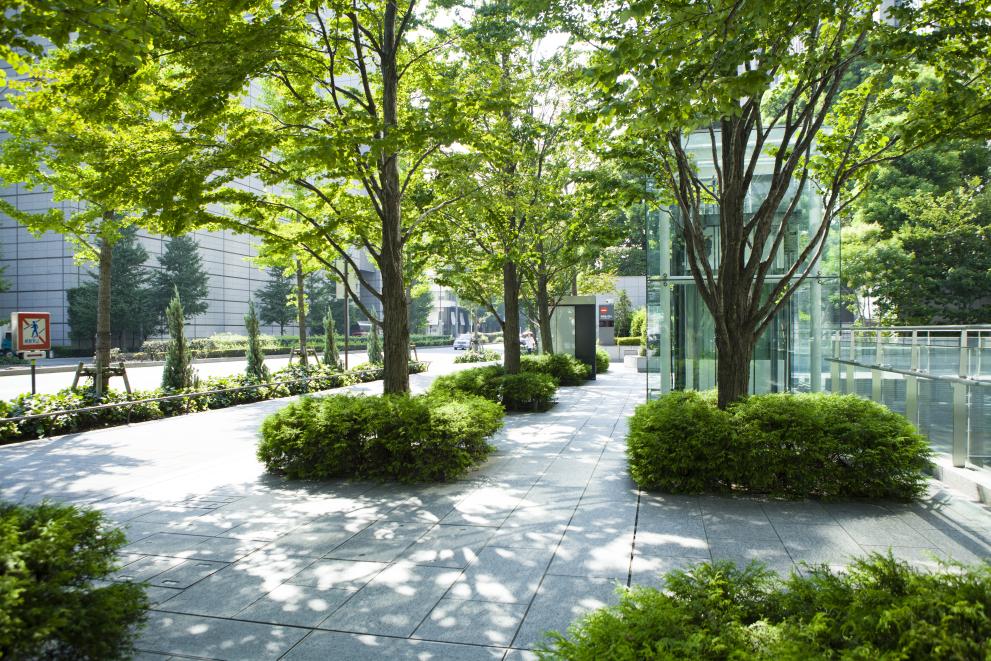
As urban areas have grown at an unprecedented rate, the problems associated with impermeable surfaces such as concrete have also been revealed, i.e. the way in which they hinder water and carbon cycling, and create a heat island effect. Solutions proposed include permeable pavements1 that allow water to infiltrate, and trees that provide ecosystem services such as cooling. However, better understanding of the effects of paving on trees is needed to guide urban planting. For example, it is not known whether permeable paving encourages deeper tree rooting, potentially reducing pavement damage from surface roots.
To find out more about the interactions of trees and different types of paving, researchers set up an experiment with two trees commonly planted in southern Europe, manna ash (Fraxinus ornus) and European hackberry (Celtis australis). They planted 24 saplings of each in Como, Italy, in four different conditions2: impermeable pavement, permeable pavers (individual blocks with gaps between), permeable concrete (resin-bound aggregate), and bare soil (as a control). Once the trees were fully established, four years after planting, they began to monitor features including above and below-ground growth and soil traits. This continued for five years, during which period annual rainfall was mostly higher than average for the region. The researchers also assessed the condition of the pavement one and eight years after the trees were initially planted.
Compared to other treatments, soil moisture was reduced underneath impermeable pavements. This was most pronounced during winter and spring, indicating a slower rehydration of paved soil during the wet seasons, but also slower dehydration in dry seasons. Upper layers never dried out to the point where trees wilted, however, and moisture levels in deeper soil were similar under both bare soil and impermeable paving. Indeed, no type of paving caused signs of drought stress in the trees or hindered above-ground growth. Overall, both species grew to the same average height and spread in paved and bare soil.
Roots were significantly affected by paving, however. Under impermeable paving, roots were thicker, shorter and fewer, and mostly confined to the top 30 cm of soil. This could not be explained by temperature or water availability, say the researchers, but was more likely due to a build-up of carbon dioxide, since gases cannot easily pass between sealed soil and air above ground. Other studies have linked carbon dioxide and root inhibition, in particular identifying a detrimental effect on a crucial enzyme (succinate dehydrogenase)3 which regulates development and stress response.
Nine years after planting, there was no significant difference in the trees’ carbon dioxide removal from the atmosphere, in bare or paved soil, nor was their cooling effect (from transpiration) significantly different. The European hackberry was more effective at both, the researchers noted. Impermeable pavement, meanwhile, led to higher soil and surface temperatures compared to bare soil, with reduced potential to provide a cooling effect through evaporation.
Both concrete and permeable pavers allow rainfall to infiltrate, but the latter do not permit substantial evaporation of water from soil, or gas exchange. In the experiment, permeable pavers were the most susceptible to being dislodged by surface roots.
Permeable concrete – which allows evaporation of soil moisture – could be the most effective option for mitigating the urban heat island effect and has the least effect on root development since it allows soil to ‘breathe’, so carbon dioxide does not build up. However, permeable concrete – usually a type of resin-bound aggregate – is not a particularly durable landscaping material, say the researchers; for instance, it is prone to cracking in freeze-thaw cycles. The insights gained from this multi-year study point to the need to explore this material further, to optimise its use in conjunction with urban tree planting.
Footnotes:
- For example, comprised of paving stones that allow water to infiltrate through gaps, or permeable concrete, made from resin-bound gravel.
- Twenty-four 50 m2 area plots were randomly assigned to four soil cover treatments, according to a randomised complete block design with six blocks.
- See: Sands, R., Nugroho, P. B., Leung, D. W. M., Sun, O. J., & Clinton, P. W. (2000). Changes in soil CO2 and O2 concentrations when radiata pine is grown in competition with pasture or weeds and possible feedbacks with radiata pine root growth and respiration. Plant and Soil, 225, 213–225.
Source:
Fini, A., Frangi, P., Comin, S., Vigevani, I., Rettori, A.A., Brunetti, C., Moura, B.B. and Ferrini, F. (2022) Effects of pavements on established urban trees: Growth, physiology, ecosystem services and disservices. Landscape and Urban Planning, 226: 104501. Available from: https://doi.org/10.1016/j.landurbplan.2022.104501
To cite this article/service:
“Science for Environment Policy”: European Commission DG Environment News Alert Service, edited by the Science Communication Unit, The University of the West of England, Bristol.
Notes on content:
The contents and views included in Science for Environment Policy are based on independent, peer reviewed research and do not necessarily reflect the position of the European Commission. Please note that this article is a summary of only one study. Other studies may come to other conclusions.
Details
- Publication date
- 15 March 2023
- Author
- Directorate-General for Environment

